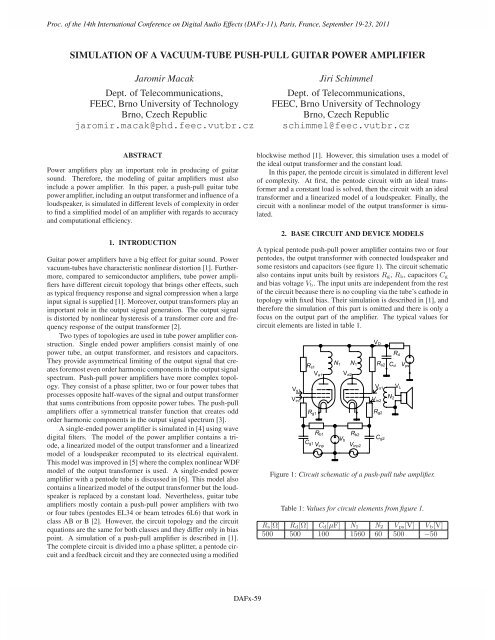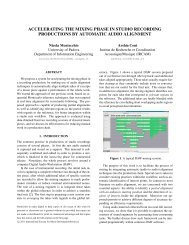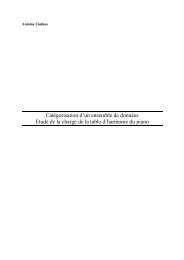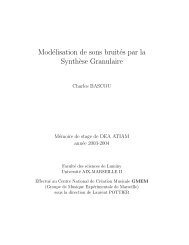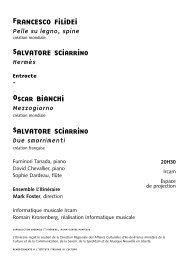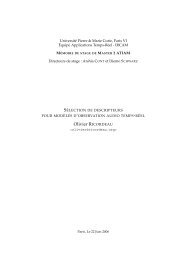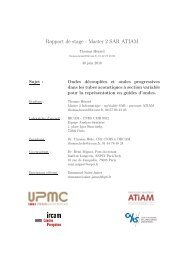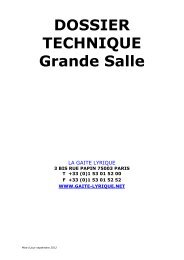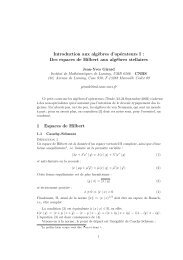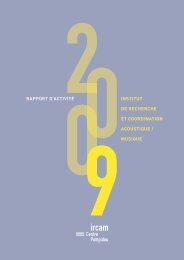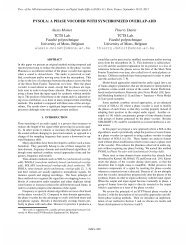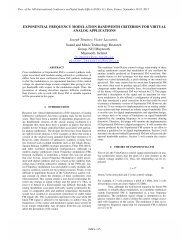Simulation of a Vacuum-Tube Push-Pull Guitar Power Amplifier
Simulation of a Vacuum-Tube Push-Pull Guitar Power Amplifier
Simulation of a Vacuum-Tube Push-Pull Guitar Power Amplifier
Create successful ePaper yourself
Turn your PDF publications into a flip-book with our unique Google optimized e-Paper software.
Proc. <strong>of</strong> the 14 th Int. Conference on Digital Audio Effects (DAFx-11), Paris, France, September 19-23, 2011Proc. <strong>of</strong> the 14th International Conference on Digital Audio Effects (DAFx-11), Paris, France, September 19-23, 2011SIMULATION OF A VACUUM-TUBE PUSH-PULL GUITAR POWER AMPLIFIERJaromir MacakDept. <strong>of</strong> Telecommunications,FEEC, Brno University <strong>of</strong> TechnologyBrno, Czech Republicjaromir.macak@phd.feec.vutbr.czJiri SchimmelDept. <strong>of</strong> Telecommunications,FEEC, Brno University <strong>of</strong> TechnologyBrno, Czech Republicschimmel@feec.vutbr.czABSTRACT<strong>Power</strong> amplifiers play an important role in producing <strong>of</strong> guitarsound. Therefore, the modeling <strong>of</strong> guitar amplifiers must alsoinclude a power amplifier. In this paper, a push-pull guitar tubepower amplifier, including an output transformer and influence <strong>of</strong> aloudspeaker, is simulated in different levels <strong>of</strong> complexity in orderto find a simplified model <strong>of</strong> an amplifier with regards to accuracyand computational efficiency.1. INTRODUCTION<strong>Guitar</strong> power amplifiers have a big effect for guitar sound. <strong>Power</strong>vacuum-tubes have characteristic nonlinear distortion [1]. Furthermore,compared to semiconductor amplifiers, tube power amplifiershave different circuit topology that brings other effects, suchas typical frequency response and signal compression when a largeinput signal is supplied [1]. Moreover, output transformers play animportant role in the output signal generation. The output signalis distorted by nonlinear hysteresis <strong>of</strong> a transformer core and frequencyresponse <strong>of</strong> the output transformer [2].Two types <strong>of</strong> topologies are used in tube power amplifier construction.Single ended power amplifiers consist mainly <strong>of</strong> onepower tube, an output transformer, and resistors and capacitors.They provide asymmetrical limiting <strong>of</strong> the output signal that createsforemost even order harmonic components in the output signalspectrum. <strong>Push</strong>-pull power amplifiers have more complex topology.They consist <strong>of</strong> a phase splitter, two or four power tubes thatprocesses opposite half-waves <strong>of</strong> the signal and output transformerthat sums contributions from opposite power tubes. The push-pullamplifiers <strong>of</strong>fer a symmetrical transfer function that creates oddorder harmonic components in the output signal spectrum [3].A single-ended power amplifier is simulated in [4] using wavedigital filters. The model <strong>of</strong> the power amplifier contains a triode,a linearized model <strong>of</strong> the output transformer and a linearizedmodel <strong>of</strong> a loudspeaker recomputed to its electrical equivalent.This model was improved in [5] where the complex nonlinear WDFmodel <strong>of</strong> the output transformer is used. A single-ended poweramplifier with a pentode tube is discussed in [6]. This model alsocontains a linearized model <strong>of</strong> the output transformer but the loudspeakeris replaced by a constant load. Nevertheless, guitar tubeamplifiers mostly contain a push-pull power amplifiers with twoor four tubes (pentodes EL34 or beam tetrodes 6L6) that work inclass AB or B [2]. However, the circuit topology and the circuitequations are the same for both classes and they differ only in biaspoint. A simulation <strong>of</strong> a push-pull amplifier is described in [1].The complete circuit is divided into a phase splitter, a pentode circuitand a feedback circuit and they are connected using a modifiedblockwise method [1]. However, this simulation uses a model <strong>of</strong>the ideal output transformer and the constant load.In this paper, the pentode circuit is simulated in different level<strong>of</strong> complexity. At first, the pentode circuit with an ideal transformerand a constant load is solved, then the circuit with an idealtransformer and a linearized model <strong>of</strong> a loudspeaker. Finally, thecircuit with a nonlinear model <strong>of</strong> the output transformer is simulated.2. BASE CIRCUIT AND DEVICE MODELSA typical pentode push-pull power amplifier contains two or fourpentodes, the output transformer with connected loudspeaker andsome resistors and capacitors (see figure 1). The circuit schematicalso contains input units built by resistors R g, R b , capacitors C gand bias voltage V b . The input units are independent from the rest<strong>of</strong> the circuit because there is no coupling via the tube’s cathode intopology with fixed bias. Their simulation is described in [1], andtherefore the simulation <strong>of</strong> this part is omitted and there is only afocus on the output part <strong>of</strong> the amplifier. The typical values forcircuit elements are listed in table 1.V s1V in1N 1V DR s2R dRN 1 s1C d V psV a1 V a2V s1 V LVN 2 in2R g1R g2R b1 R b2VC bC g2g1 Vinp Vinp2Figure 1: Circuit schematic <strong>of</strong> a push-pull tube amplifier.Table 1: Values for circuit elements from figure 1.R s[Ω] R d [Ω] C d [µF] N 1 N 2 V ps[V] V b [V]500 500 100 1560 60 500 −50DAFX-1DAFx-59
Proc. <strong>of</strong> the 14 th Int. Conference on Digital Audio Effects (DAFx-11), Paris, France, September 19-23, 2011Proc. <strong>of</strong> the 14th International Conference on Digital Audio Effects (DAFx-11), Paris, France, September 19-23, 20112.1. Pentode ModelThe Koren’s model <strong>of</strong> the pentode [7] was chosen as the pentodemodel. The pentode plate current is in form I a(V ak , V gk1 , V gk2 )where V ak is plate-to-cathode voltage, V g1k is the grid-to-cathodevoltage and U g2k is the screen-to-cathode voltage. The screen currentis given in form I s(V gk1 , V gk2 ). The description <strong>of</strong> functionsI a and I s is omitted here and is available in [7]. Frequency properties<strong>of</strong> the tube (e.g. Miller capacitance) are not considered becauseit should be included in the simulation <strong>of</strong> input unit.2.2. Output Transformer ModelAn ideal output transformer is considered to be an impedance dividerthat transforms input voltages V p and currents I p to outputV s and I s according to2.3. Loudspeaker ModelLoudspeakers play a very important role in the output signal generationvia its frequency response. When considering linearizedloudspeakers, one can model the frequency response with measuredimpulse responses with good results [1]. However, it is importantto simulate the interaction between the tube amplifier andloudspeaker because the loudspeaker impedance is frequency dependent.The impedance can be modeled using the circuit schematicin figure 2 [12]. The values are derived from the added massmethod and Thiele/Small parameters <strong>of</strong> a Celestion Vintage 30loudspeaker placed in an Engl combo. The transformer leakageinductance and resistance can be modeled by modifying inductorL sp1 and resistor R sp1 values.V sV p= N2N 1= IpI s(1)where N 1, N 2 are numbers <strong>of</strong> windings <strong>of</strong> the transformer. However,a real transformer is far away from the ideal one. For an accuratesimulation, losses caused by hysteresis and core saturationhave to be considered. Nonlinear behavior <strong>of</strong> the real transformeris described in numerous literature, e.g. [8, 9]. According to Amper’slaw, the magnetizing force H isHl mag = N 1I p − N 2I s (2)where l mag is the length <strong>of</strong> the induction path. The flux density Bis computed from Farraday’s law∂B∂t =Vs(3)N 2Swhere S is the transformer-core cross-section. The well-knownnonlinear relation B = µH can be implemented according to theFrolich equation [9] given byB =Hc + b |H|where c and b are constants derived from material properties. However,this model simulates only the core saturation. When simulatinghysteresis, one can use e.g. Jiles-Atherton model [10] modifiedin [8] in order to remove nonphysical behavior <strong>of</strong> minor hysteresisloops. Magnetization <strong>of</strong> the core is obtained from∂M∂H = M an − MδM + c ∂Mankδ ∂Hwhere M an is anhysteretic curve given by( H + αMM an = M s(cotha)−)aH + αMand δ =sign(∂H/∂t). Parameters M s, α, a, c and k are derivedfrom material properties and their identification can be found e.g.in [11]. Parameter δ M =0when the nonphysical minor loop is goingto be generated (anhysteric magnezation has lower value thanthe irreversible magnezation) alternatively δ M =1[8] . Flux densityis then obtained from(4)(5)(6)B = µ 0 (M + H) . (7)Figure 2: Simplified loudspeaker model – electric equivalent.The loudspeaker impedance given by voltage V L and currentI L can be expressed as the solution <strong>of</strong> the set <strong>of</strong> equationsVL[n] − IL[n]Rsp1 − V3[n]I L[n] =I L[n − 1] +L sp1f sV3[n]Gsp2 − IL[n] − IL2[n]V 3[n] =V 3[n − 1] + (8)C sp1f sI L2[n] =I L2[n − 1] + V3[n]L sp2f swhere I L[n − 1], V 3[n − 1], I L2[n − 1] are state variables andf s is a sampling frequency. The equations were obtained usingnodal analysis <strong>of</strong> the circuit in figure 2 and then discretized usingBackward Euler formula.Because the set <strong>of</strong> equations (8) is linear, it can be simplifiedinto one linear equationI L[n] =−c 1V L[n]+I tmp (9)where I tmp is a linear combination <strong>of</strong> state variables given byI tmp = −c 2I L[n − 1] + c 3V 3[n − 1] − c 4I L2[n − 1]. (10)The new state variable values are then computed fromV 3[n] =−c 5V 3[n − 1] − c 6I L[n]+c 7I L2[n − 1] (11)andI L2[n] =I L2[n − 1] + c 8V 3[n]. (12)Coefficients c 1−8 are derived from (8).3. SIMULATION OF THE AMPLIFIERIn the simplest case, the load is considered to be constant. Usingnodal analysis and discretization by Euler method, one can obtainthe set <strong>of</strong> circuit equationsDAFX-2DAFx-60
Proc. <strong>of</strong> the 14 th Int. Conference on Digital Audio Effects (DAFx-11), Paris, France, September 19-23, 2011Proc. <strong>of</strong> the 14th International Conference on Digital Audio Effects (DAFx-11), Paris, France, September 19-23, 20114. SIMULATION RESULTS0=− VL[n] + N1(I a1 − I a2)R L N 20=−V a1[n]+V D[n] − N1V L[n]N 20=−V a2[n]+V D[n]+ N1V L[n]N 2VD[n] − Vs1[n]0=I s1 +0=I s2 +R s1VD[n] − Vs2[n]R s2,(13)where V D is voltage on the power supply, capacitor C d is from thecircuit schematic in figure 1 and I a1 = I a(V in1[n],V a1[n],V s1[n]),I s = I s (V in1[n],V s1[n]) and similarly I s2 = I s (V in2[n],V s2[n])and I a2 = I a(V in2[n],V a2[n],V s2[n]). The equations (13) aresolvable for given value V D and the solution can be implementedusing a static waveshaper. It can be precomputed for different values<strong>of</strong> V D voltage and stored in a look-up table. Then, during thesimulation, the proper static waveshaper is chosen according to theV D voltage. The V D voltage is then actualized usingV D[n] = −Ia1 − Ia2 − Is1 − Is2 + (V PS−V D [n−1 ])R D+ V D[n − 1].C 1f fs(14)3.1. Circuit with Loudspeaker ModelIf the loudspeaker is connected to the power amplifier, the loadimpedance is no longer given explicitly, but it is determined by V L,I L relation implicitly given by equations (8). In order to excludethe loudspeaker impedance R L, the first equation from system (13)is modified toI L[n] = N1(I a1 − I a2) (15)N 2and then solution <strong>of</strong> the modified equations (13) with (15) is expressedas a function I L[n] =f IL (V in1[n],V in2[n],V D[n],V L[n]).Finally, the solution <strong>of</strong> the whole system using (9) is given by− c 1V L[n]+I tmp = f IL (16)for the unknown variable V L[n] and state variables I tmp and V D[n].3.2. Circuit with Nonlinear Transformer ModelThe simulation <strong>of</strong> a circuit with a nonlinear transformer model isbased on (2), (3) and the nonlinear core model. The system isdescribed using0=−H(B[n])l mag − (c 1V L[n]+I tmp)N 2 + f ILN 20=B[n − 1] − B[n]+VL(17)N 2Sf swhere term f ILN 2 is recomputed current I L to primary winding,B[n − 1] is the flux density in the previous sampling period andH(B) is the core model derived from (4) or from (7) if the hysteresisis considered.All the simulations from section 3 were implemented in Matlabenvironment using Mex files and C language. The Newton methodwas used for solving implicit nonlinear equations. The derivation<strong>of</strong> function or the Jacobian matrix were obtained using finite differenceformula, the maximal number <strong>of</strong> iterations was 100 and thenumerical error was chosen as 0.0001. The values for the transformermodel were chosen experimentally: M s = 1.11 × 10 6 ,3a =8.56, α =8.82×10 −5 , c =0.14 and k =51.65. However,they can be computed from a measured hysteresis loop data [11].The parameters for the Frohlich core model were c = 113.38,b =0.71 and the dimensions <strong>of</strong> the transformer were chosen asS =0.003 m 2 and l mag =0.2 m.The transformer-core cross-section S together with the number<strong>of</strong> windings determines the low cut<strong>of</strong>f frequency <strong>of</strong> the transformer.The simulation <strong>of</strong> the output part <strong>of</strong> the power amplifierwas appended with a phase splitter, input pentode unit and feedbackaccording to [1] and the results were compared to the measuredEngl combo. The data was obtained from a measured voltageon a parallel loudspeaker output with connected soundcard. Thefrequency dependence <strong>of</strong> the first harmonic content <strong>of</strong> the voltageoutput signal, obtained using sweep sine signal, is shown infigure 3. The simulation with a constant load provides the worstresults – there is no resonance around 45 Hz that appears in all<strong>of</strong> the other simulations and measured data. The simulation withhysteresis loop has similar behavior as a measured amplifier in thearea <strong>of</strong> low frequencies due to the core losses. In the area <strong>of</strong> midfrequencies,the simulation and measured data differ because <strong>of</strong>the other resonances and mechanical properties <strong>of</strong> the loudspeakerdiaphragm, which are not considered in the simulation but can beincluded in the simulation by improving the loudspeaker modellike in [13]. The nonlinear distortion was investigated as well. Theoutput spectrum for an input sinewave signal with an amplitude <strong>of</strong>2 V is shown in figures 4. The individual spectra are measured forthe same frequency but they are shifted in the graph. All the algorithmsexcluding the variant with constant load give very similarresults. The nonlinear distortion caused by transformer hysteresismanifests very slightly and only at frequencies below cca 150 Hzand it is very dependent on transformer parameters. The spectrogram<strong>of</strong> simulation using JA-model is shown in figure 5.The table 2 shows the hypothetical computational complexitythat was determined using measurement <strong>of</strong> time duration <strong>of</strong> simulationfor input guitar riff signal with a length <strong>of</strong> 18 s and an amplitude<strong>of</strong> 30 V. The results showed that the algorithm is capable <strong>of</strong>working in real-time. Sound examples <strong>of</strong> all the algorithm variantsand detailed graphs and other spectrograms are available on theweb page www.utko.feec.vutbr.cz/~macak/DAFx11/.Table 2: Normalized computational complexity.Constant load Loudspeaker Frohlich J-A model0.04 % 0.05 % 0.12 % 0.27 %5. CONCLUSIONSThe simulation <strong>of</strong> a push-pull tube amplifier was discussed in thispaper. The impact <strong>of</strong> the loudspeaker and output transformer toDAFX-3DAFx-61
Proc. <strong>of</strong> the 14 th Int. Conference on Digital Audio Effects (DAFx-11), Paris, France, September 19-23, 2011Proc. <strong>of</strong> the 14th International Conference on Digital Audio Effects (DAFx-11), Paris, France, September 19-23, 2011the amplifier properties was investigated. The loudspeaker wasmodeled using simplified electric circuit and Frohlich and Jiles-Atherton transformer models were used. The results showed thatthe output transformer had a minor impact on the simulation results.It only manifested at very low frequencies while the computationalcomplexity was increased significantly. Both transformermodels provided very similar simulation results and therefore, theFrohlich model is more efficient for real-time simulations.f [Hz]100001000100M [dB]40353025201510MeasuredJ−A modelFrohlichLoudspeakerConstant load100 0.5 1 1.5 2 2.5 3t [s]Figure 5: Spectrogram <strong>of</strong> output signal for simulation with JAmodel <strong>of</strong> transformer.50−5−1010 0 10 2 10 4f [Hz]Figure 3: Frequency dependence <strong>of</strong> the first harmonic content <strong>of</strong>the output signal.M [dB]3020100−10−20J−A modelFrohlichLoudspeakerConstant loadMeasured−300 100 200 300 400 500 600 700 800 900f [Hz]Figure 4: Output spectrum for input 90 Hz sinewave.6. ACKNOWLEDGMENTSThis paper was supported by the Fund <strong>of</strong> the Council <strong>of</strong> HigherEducation Institutions <strong>of</strong> the Czech Republic under project no.2704/2011 and project no. FR-TI1/495 <strong>of</strong> the Ministry <strong>of</strong> Industryand Trade <strong>of</strong> the Czech Republic.7. REFERENCES[1] J. Macak and J. Schimmel, “Real-time guitar tube amplifiersimulation using approximation <strong>of</strong> differential equations,” inProceedings <strong>of</strong> the 13th International Conference on DigitalAudio Effects DAFx10, Graz, Austria, Sep. 6-10, 2010.[2] D. Self et al, Audio Engineering, Elsevier, Burlington, MA,USA, 1 st edition, 2009.[3] U. Zölzer, DAFX - Digital Audio Effects, J. Wiley & Sons,Ltd, 1 st edition, 2002.[4] J. Pakarinen, M. Tikander, and M. Karjalainen, “Wave digitalmodeling the output chain <strong>of</strong> a vacuum-tube amplifier,”in Proc. Intl. Conf. on Acoustics, Speech, and Signal Proc.,Como, Italy, Sept. 1-4, 2009, pp. 55–59.[5] R. C. D. de Paiva, J. Pakarinen, V. Välimäki, and M. Tikander,“Real-time audio transformer emulation for virtual tubeamplifiers,” EURASIP Journal on Advances in Signal Processing,vol. 2011, pp. 15, 2011.[6] I. Cohen and T. Helie, “Real-time simulation <strong>of</strong> a guitarpower amplifier,” in Proceedings <strong>of</strong> the 13th InternationalConference on Digital Audio Effects DAFx10, Graz, Austria,Sep. 6-10, 2010.[7] N. Koren, “Improved vacuum tube models for SPICEsimulations,” Available at http://www.normankoren.com/Audio/<strong>Tube</strong>modspice_article.html, 2003.[8] P. Kis, Jiles-Atherton Model Implementation to Edge FiniteElement Method, Ph.D. thesis, Budapest University <strong>of</strong> Technologyand Economics, 2010.[9] S. E. Zocholl, A. Guzman, and D. Hou, “Transformermodeling as applied to differential protection,” Tech. Rep.,Schweitzer Engineering Laboratories, Inc. <strong>Pull</strong>man, Washington,1999.[10] D. C. Jiles and D. L. Atherton, “Ferromagnetic hysteresis,”IEEE Transactions on Magnetics, , no. 5, pp. 2183–2185,1983.[11] D. C. Jiles, J. B. Thoelke, and M. K. Devine, “Numericaldetermination <strong>of</strong> hysteresis parameters for the modeling <strong>of</strong>magnetic properties using the theory <strong>of</strong> ferromagnetic hysteresis,”IEEE Transactions on Magnetics, vol. 28, no. 1, pp.27–35, 1992.[12] R. Elliot, “Measuring Thiele / Small Loudspeaker Parameters,”Available at http://sound.westhost.com/tsp.htm, 2007.[13] J. Pakarinen, M. Tikander, and M. Karjalainen, “Wave digitalmodeling <strong>of</strong> the output chain <strong>of</strong> a vacuum-tube amplifier,” inProc. <strong>of</strong> the Int. Conf. on Digital Audio Effects (DAFx-09),Como, Italy, Sept. 1–4, 2009.DAFX-4DAFx-62


